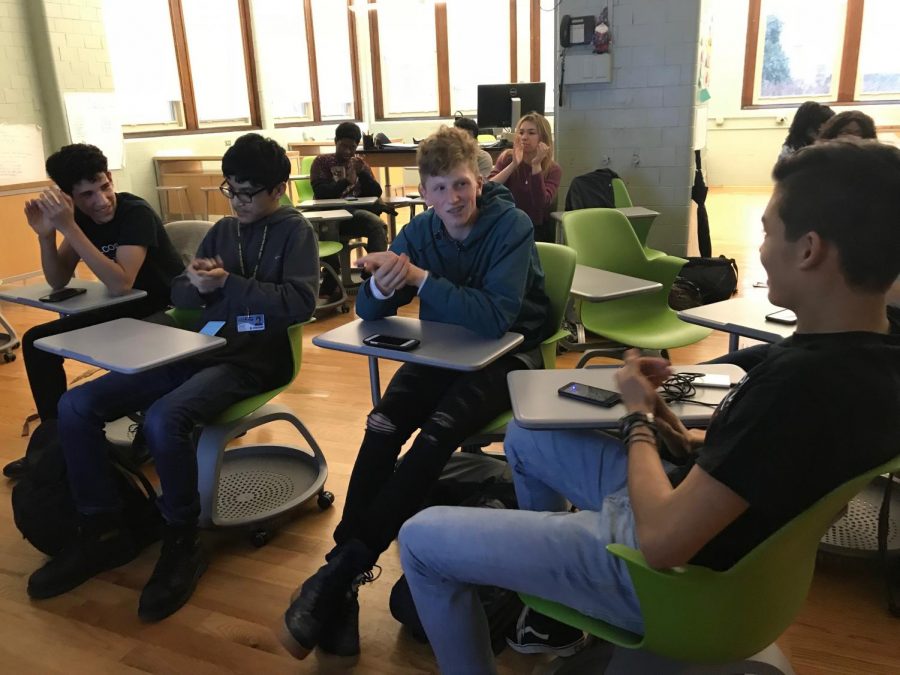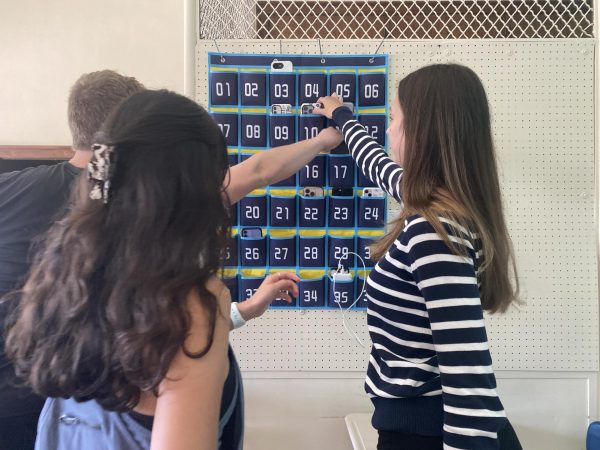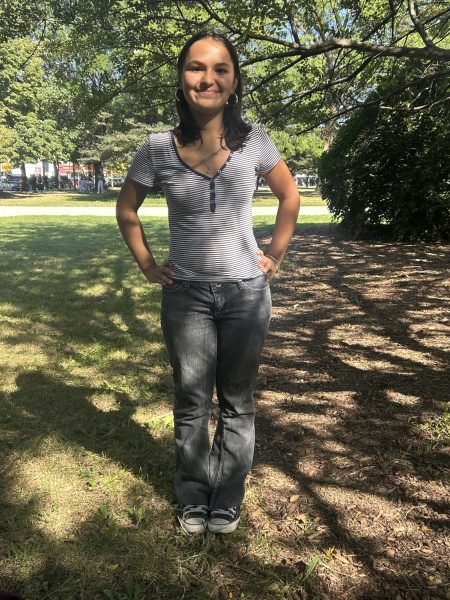Students drop beats at the 4th annual Mix-Off competition
Finalists clap and congratulate each other as the winner and runner ups of the 2018 Mix-Off competition were being announced on Feb. 20 in the STEM lab.
When hip-hop trio Migos released their third studio album “Culture II” in late January, it became an inspiration for Henry Landgraff, Div. 056, in his Media Computation class.
“I was listening to it and I was like, ‘You know, I could make a beat like this,’” Landgraff said.
On Feb. 20, the computer science department held its fourth annual Mix-Off competition in the STEM lab after school. Songs created by six students taking Media Computation were put in a head-to-head battle to be chosen as the winner through votes cast by students also attending the Mix-Off.
The three finalists would have their name put on a banner displayed in the Media Computation class, and the overall Mix-Off winner would win a pizza party for their class.
“I think that it lets students really become invested in their work in the classroom,” Ms. Wozniak, Media Computation teacher, said. “I feel like having a competition sometimes can give students more of an investment in what they’re creating.”
The competitors — who were chosen by students in their Media Computation class — prepared two songs in the case that they make it to the final round.
However, only three students got to advance to the final round.
“There’s a bit of a gamble in this,” Wozniak said. “If you play your best song and you get to the final round, your second song might not be good enough to get you first, so you really have to have two solid songs in this competition to win.”
Media Computation is an introductory programming class offered in the computer science department. Students in the class learn the programming language Python through different forms of media, such as music, images and animations, Wozniak said.
“A lot of programming is just problem solving,” Mr. Kim, Media Computation teacher, said. “You’re going to be dealt with difficult problems so one thing I want students to gain is to not give up when they’re faced with this difficult problem and to just work through it — that’s what the class is all about.”
In the first elimination round, two songs are randomly be selected to go head-to-head.
After listening to both songs, students voted for either Song A and Song B on a website using their phones. The names of the competitors who created the songs were revealed after a winner of the match was determined.
The songs were about one minute long. They included a variety of styles and sounds like upbeat electronic music, deep house EDM, fast-paced techno music, acoustic guitar and downtempo hip-hop.
“The first year I did it, the songs were longer, but then I learned my lesson because the Mix-Off was about an hour, and kids get a little antsy,” Wozniak said. “Now, the songs are between a minute and a minute and a half.”
The competitors who got to advance to the final round were Fernando Alvarado, Charlie Drohomyrecky and Henry Landgraff.
In the first matchup, songs created by Fernando Alvarado and Nathaniel Krok permeated the room from large speakers.
Fernando Alvarado (winner of matchup)
Nathaniel Krok
The students created the songs using a coding program called EarSketch. The program allows users to create music by “manipulating loops, composing beats, and applying effects to a multi-track digital audio workstation,” according to EarSketch’s website.
“It’s similar to Garageband but with Garageband, you drag and drop things — you drag and drop effects, you drag and drop beats — here, you write lines of code that put those sounds,” Wozniak said.
In the second matchup, Johan Sandoval went up against Charlie Drohomyrecky.
Johan Sandoval
Charlie Drohomyrecky (winner of matchup)
The third matchup featured Henry Landgraff and Andrew Hernandez.
Henry Landgraff (winner of matchup)
Andrew Hernandez
As the songs played through the speakers, students sat in their chairs and mostly listened in silence. Some bobbed their head to the music. Another student dabbed.
When Landgraff’s own song played, he found himself in an uncomfortable position.
“It was super awkward because I didn’t want to look around and see people’s faces judging me,” Landgraff said.
In the last round, the three finalists played their second songs. Students were asked to vote for their two favorites. The finalist to receive the most votes in the last round would win the competition.
Fernando Alvarado
Henry Landgraff
Charlie Drohomyrecky
After voting ended, Henry Landgraff was announced as the winner by only a few votes. Charlie Drohomyrecky took second place and Fernando Alvarado took third place.
“I was not expecting to win,” Landgraff said. “I was listening to the other ones and honestly they were all so good, so it’s crazy that I won.”
Landgraff has prior experience with creating music, but it was his first time creating music through coding, he said. It took him a total of about five days to create both of his songs.
During those days, Landgraff said he continued to tweak and perfect his songs while also receiving continual feedback from his friend in Media Computation class.
“If you try hard enough on something and you’re happy with it, it pays off,” Landgraff said. “You can make everything sound a little bit better, but when you’re content with it and you think it sounds good, just go with it.”
This year’s Mix-Off was different than years past because before, the top two students from each class would be chosen to compete since there were only three sections of Media Computation. Now, there are six sections of Media Computation classes taught by either Wozniak or Kim, and only the top student from each class was chosen to compete at Mix-Off, Wozniak said.
Kim, who is Landgraff’s Media Computation teacher, said it was his first year attending Mix-Off as a teacher for the class.
“I was very excited because I had my own students involved,” Kim said. “All the songs were phenomenal, and I think any one of those songs on any different day could have won, but I was really excited that Henry [Landgraff] won.”
There were fewer students who attended this year’s Mix-Off, Wozniak said. In previous years approximately 50-60 students attended the event, but this year only about 30 students attended.
Nonetheless, Wozniak said she believes the event was still a success because the Mix-Off competitors were able to share and be proud of their work.
“It’s just a celebration of their music,” Wozniak said. “We invite the classes to come and celebrate and support their class representative. For the other students who come that aren’t in our class, maybe they go, ‘Oh, this is pretty cool. I wanna learn how to do that.’”
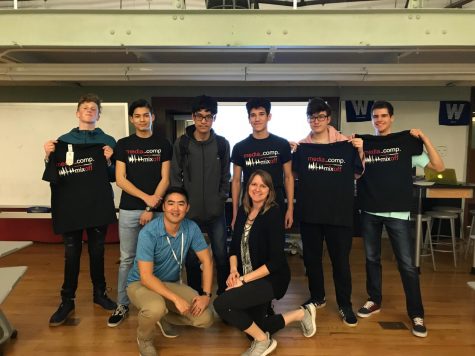
Mix off competitors (left to right) Henry Landgraff, Charlie Drohomyrecky, Andrew Hernandez, Fernando Alvarado, Johan Sandoval and Nathaniel Krok with their teachers Mr. Kim and Ms. Wozniak after the Mix-Off competition on Feb. 20.
Your donations directly fund the Lane Tech student journalism program—covering essential costs like website hosting and technology not supported by our school or district. Your generosity empowers our student reporters to investigate, write, and publish impactful stories that matter to our school community.
This website is more than a publishing platform—it's an archive, a research tool, and a source of truth. Every dollar helps us preserve and grow this resource so future students can learn from and build on the work being done today.
Thank you for supporting the next generation of journalists at Lane Tech College Prep!
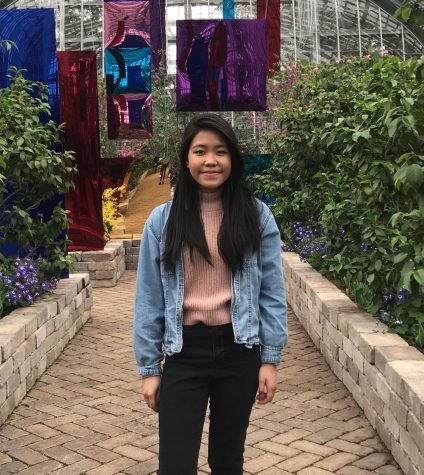
Eunice Alpasan was born in the Philippines and moved to the U.S. when she was three years old. She enjoys listening to music and watching movies. Eunice...

